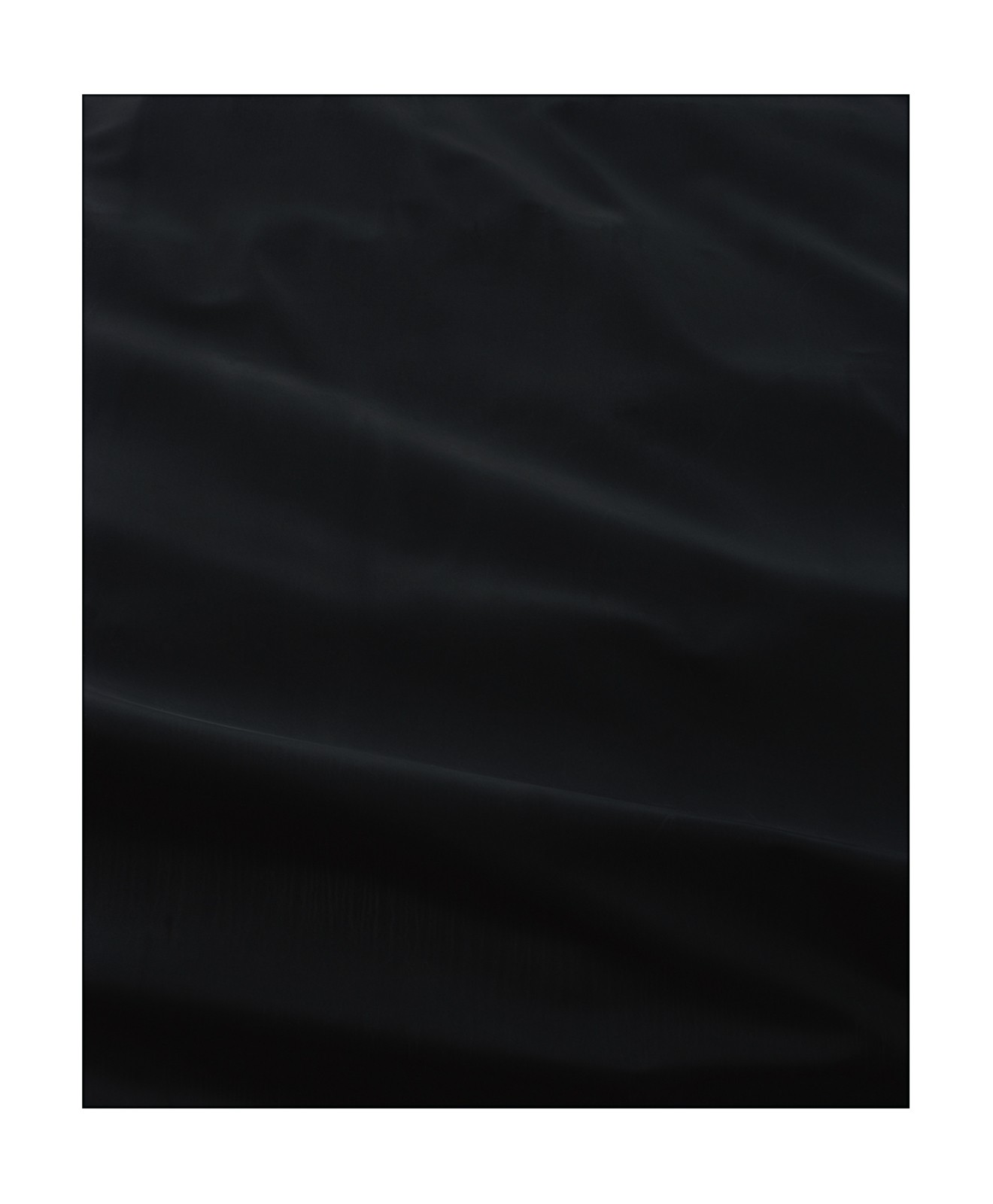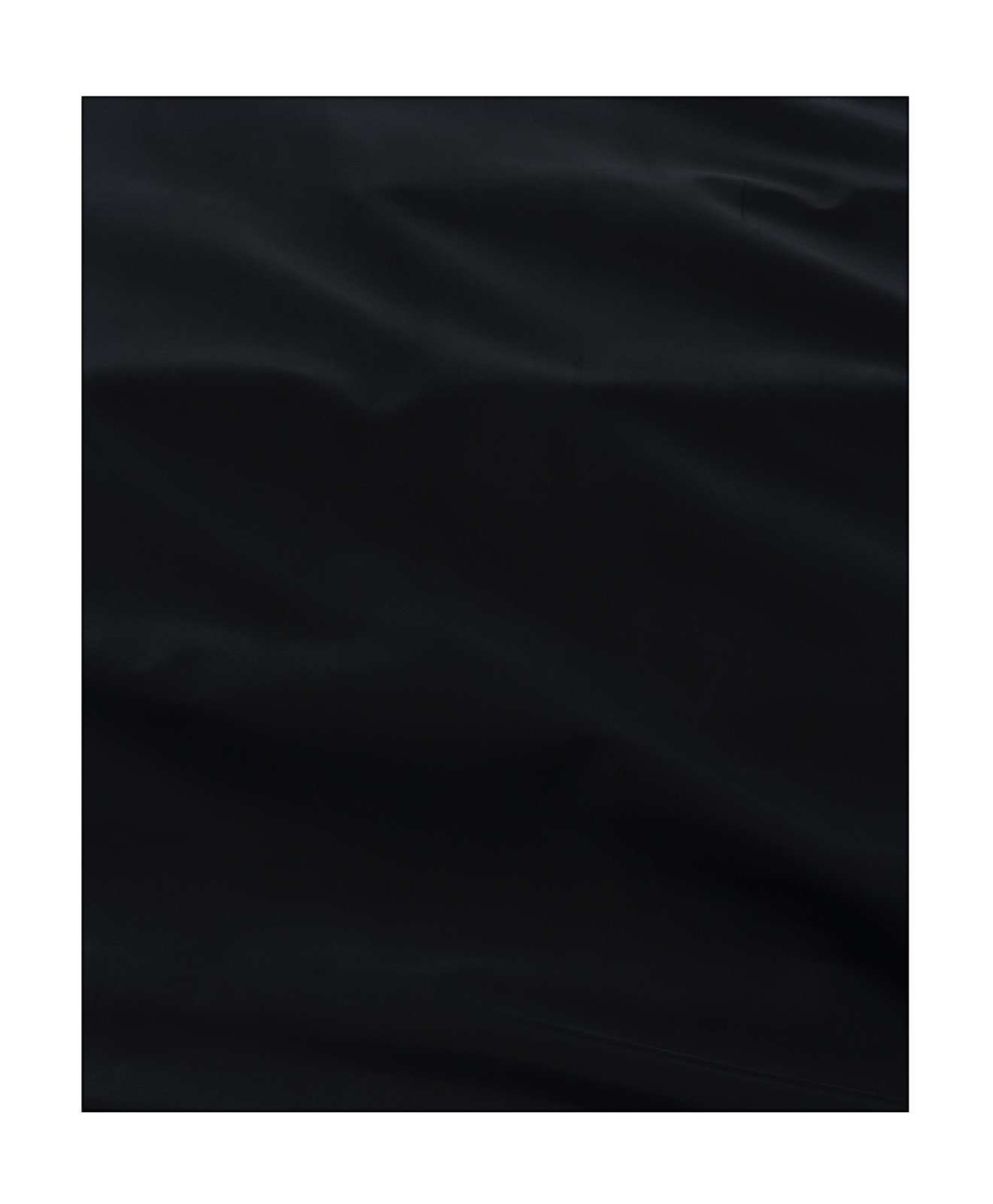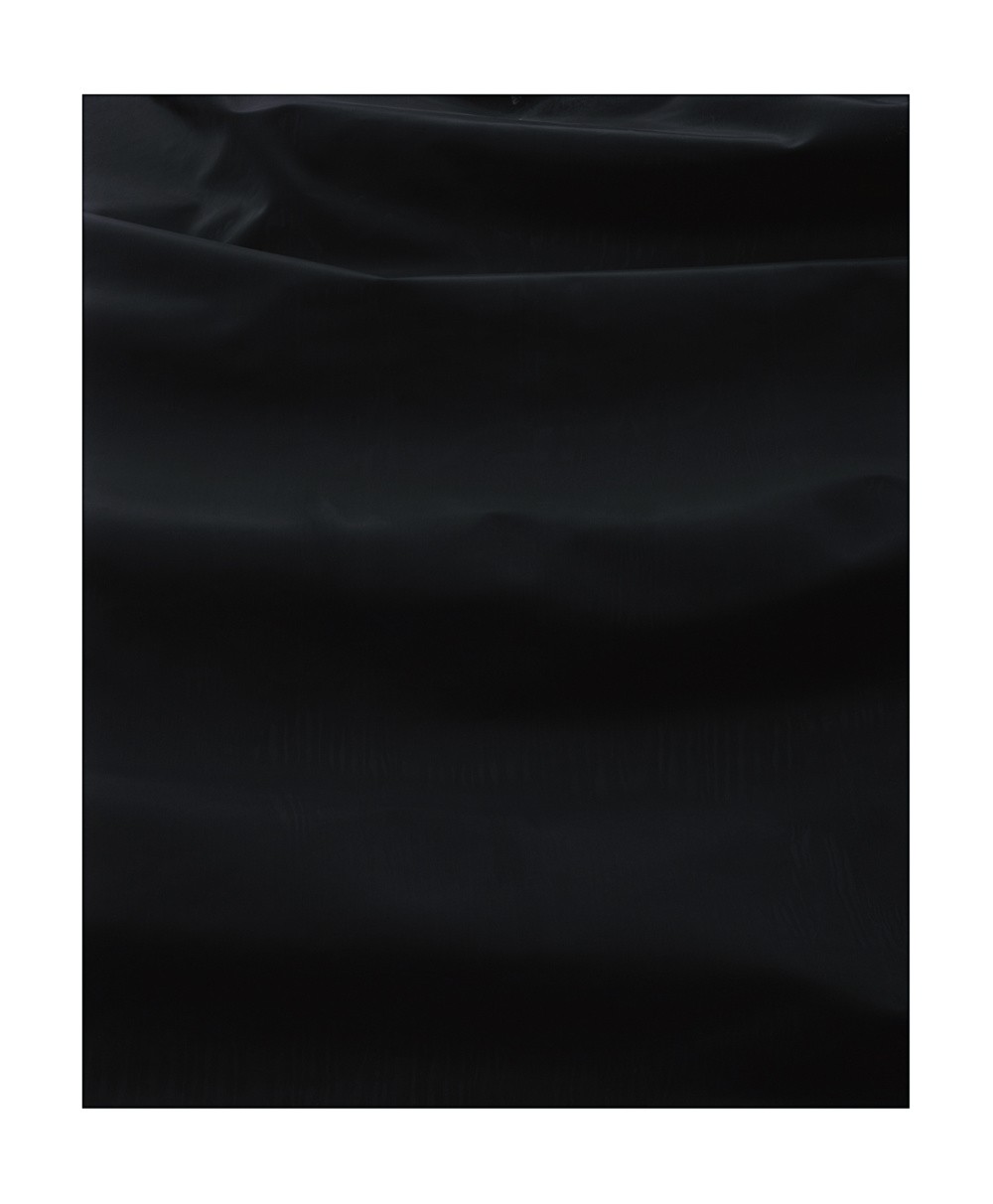HDPE
Fuji Matt photo paper, Archival digital C-type print, © 2018

ENGLISH
In the Anthropocene epoch, the Earth’s environment is affected both locally and globally by the effects of human activity, which alters the balance of nature. The landscape reveals the image of reality, hence the perceptual-cultural relationship between human beings and the latter.
The series portrays the high-density polyethene that extends over the monumental piles of one of the main waste storage sites in Giugliano - Masseria del Re in the province of Naples. The HDPE covers - resistant to chemicals - are used to isolate the waste bales in the indefinite wait for their disposal.
In this sequence of ten monochrome images, the black surface - like the negation of colour, which represents the absolute limit - appears to be shaped by the folds of the decaying waste and marked by atmospheric agents. Time becomes material space.
Every detail is made accessible thanks to the precision of the large format.
Stacked for years on a plot of land in the Terra dei Fuochi (Land of Fires) in the middle of cultivated fields, the compressed waste constitutes environmental risks related to air, water, and soil pollution.
The work also reflects on the transformations of the landscape.
The panoramas have been modified by human intervention. The forms of nature have changed, but so has our perception of it: in the visual field, the black monochrome predominates and conditions the observation of the landscape by those who inhabit it and those who pass through it.
These intrusive elements are rarely seen up close. The areas where they have been positioned are avoided or forbidden.
It is no longer the “Campania Felix” with the fertile soil of the Romans and it does not even offer the same enchanting views admired by the travellers on the Grand Tour in the 17th and 18th centuries.
Each of the images takes its title from a toxic heavy metal that is present in the soil of the area in high and dangerous concentrations: antimony, arsenic, beryllium, cadmium, chromium, lead, manganese, nickel, selenium, and vanadium.
ITALIANO
Nell’era dell’Antropocene, l’ambiente terrestre è condizionato sia a livello locale che globale dagli effetti dell’azione dell’uomo, che alterano gli equilibri naturali. Il paesaggio indica l’immagine della realtà, quindi il rapporto percettivo-culturale che si stabilisce fra l’uomo e quest’ultima.
La serie ritrae il polietilene ad alta densità che copre gli ammassi monumentali di uno dei principali siti di stoccaggio rifiuti a Giugliano - Masseria del Re in provincia di Napoli. I teli in HDPE, resistenti alle sostanze chimiche, servono ad isolare le ecoballe nell’indefinita attesa del loro smaltimento.
In questa successione di dieci immagini monocolore, la superficie nera - come la negazione del colore, che rappresenta il limite assoluto - appare modellata dalle pieghe dei rifiuti in decomposizione e segnata da agenti atmosferici. Il tempo diventa spazio materiale.
Ogni particolare è reso accessibile grazie alla precisione del grande formato.
Accatastati per anni su terreni della Terra dei Fuochi, in mezzo a campagne coltivate, i rifiuti compressi costituiscono rischi ambientali legati all’inquinamento atmosferico, idrico e del suolo.
Il lavoro riflette anche sulle trasformazioni del paesaggio.
I panorami sono stati alterati dall’intervento umano. Sono mutate le forme della natura, ma anche la percezione che abbiamo di essa: nel campo visivo la monocromia nera predomina e condiziona l’osservazione del paesaggio da parte di chi lo abita e di chi lo attraversa.
Quasi mai, invece, questi elementi intrusi vengono visti da vicino. Le zone in cui sono stati collocati vengono evitate o sono vietate.
Non è più la “Campania Felix” con il suolo fertile dei Romani e non offre nemmeno gli stessi panorami incantevoli ammirati dai viaggiatori del Grand Tour nel 17° e 18° secolo.
Ciascuna delle immagini prende il titolo da un metallo pesante tossico, che nel terreno dell’area risulta presente in concentrazioni elevate e pericolose: antimonio, arsenico, berillio, cadmio, cromo, piombo, manganese, nichel, selenio e vanadio.


Cadmium

Arsenic

Antimony

Manganese

Chrome

Beryllium

Nickel

Vanadium

Selenium

Lead
HDPE
Fuji Matt photo paper, Archival digital C-type print, © 2018

ENGLISH
In the Anthropocene epoch, the Earth’s environment is affected both locally and globally by the effects of human activity, which alters the balance of nature. The landscape reveals the image of reality, hence the perceptual-cultural relationship between human beings and the latter.
The series portrays the high-density polyethene that extends over the monumental piles of one of the main waste storage sites in Giugliano - Masseria del Re in the province of Naples. The HDPE covers - resistant to chemicals - are used to isolate the waste bales in the indefinite wait for their disposal.
In this sequence of ten monochrome images, the black surface - like the negation of colour, which represents the absolute limit - appears to be shaped by the folds of the decaying waste and marked by atmospheric agents. Time becomes material space.
Every detail is made accessible thanks to the precision of the large format.
Stacked for years on a plot of land in the Terra dei Fuochi (Land of Fires) in the middle of cultivated fields, the compressed waste constitutes environmental risks related to air, water, and soil pollution.
The work also reflects on the transformations of the landscape.
The panoramas have been modified by human intervention. The forms of nature have changed, but so has our perception of it: in the visual field, the black monochrome predominates and conditions the observation of the landscape by those who inhabit it and those who pass through it.
These intrusive elements are rarely seen up close. The areas where they have been positioned are avoided or forbidden.
It is no longer the “Campania Felix” with the fertile soil of the Romans and it does not even offer the same enchanting views admired by the travellers on the Grand Tour in the 17th and 18th centuries.
Each of the images takes its title from a toxic heavy metal that is present in the soil of the area in high and dangerous concentrations: antimony, arsenic, beryllium, cadmium, chromium, lead, manganese, nickel, selenium, and vanadium.
ITALIANO
Nell’era dell’Antropocene, l’ambiente terrestre è condizionato sia a livello locale che globale dagli effetti dell’azione dell’uomo, che alterano gli equilibri naturali. Il paesaggio indica l’immagine della realtà, quindi il rapporto percettivo-culturale che si stabilisce fra l’uomo e quest’ultima.
La serie ritrae il polietilene ad alta densità che copre gli ammassi monumentali di uno dei principali siti di stoccaggio rifiuti a Giugliano - Masseria del Re in provincia di Napoli. I teli in HDPE, resistenti alle sostanze chimiche, servono ad isolare le ecoballe nell’indefinita attesa del loro smaltimento.
In questa successione di dieci immagini monocolore, la superficie nera - come la negazione del colore, che rappresenta il limite assoluto - appare modellata dalle pieghe dei rifiuti in decomposizione e segnata da agenti atmosferici. Il tempo diventa spazio materiale.
Ogni particolare è reso accessibile grazie alla precisione del grande formato.
Accatastati per anni su terreni della Terra dei Fuochi, in mezzo a campagne coltivate, i rifiuti compressi costituiscono rischi ambientali legati all’inquinamento atmosferico, idrico e del suolo.
Il lavoro riflette anche sulle trasformazioni del paesaggio.
I panorami sono stati alterati dall’intervento umano. Sono mutate le forme della natura, ma anche la percezione che abbiamo di essa: nel campo visivo la monocromia nera predomina e condiziona l’osservazione del paesaggio da parte di chi lo abita e di chi lo attraversa.
Quasi mai, invece, questi elementi intrusi vengono visti da vicino. Le zone in cui sono stati collocati vengono evitate o sono vietate.
Non è più la “Campania Felix” con il suolo fertile dei Romani e non offre nemmeno gli stessi panorami incantevoli ammirati dai viaggiatori del Grand Tour nel 17° e 18° secolo.
Ciascuna delle immagini prende il titolo da un metallo pesante tossico, che nel terreno dell’area risulta presente in concentrazioni elevate e pericolose: antimonio, arsenico, berillio, cadmio, cromo, piombo, manganese, nichel, selenio e vanadio.


Cadmium

Arsenic

Antimony

Manganese

Chrome

Beryllium

Nickel

Vanadium

Selenium

Lead